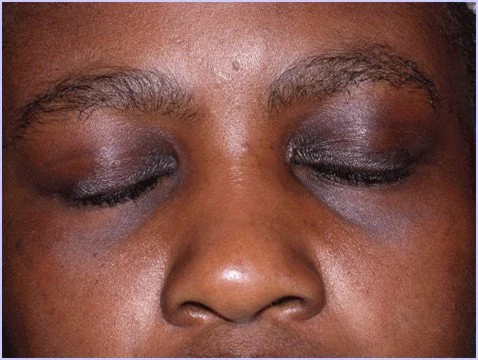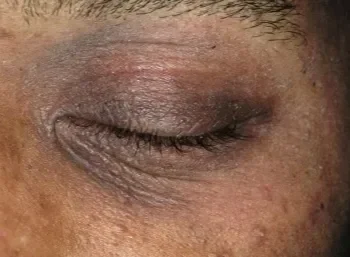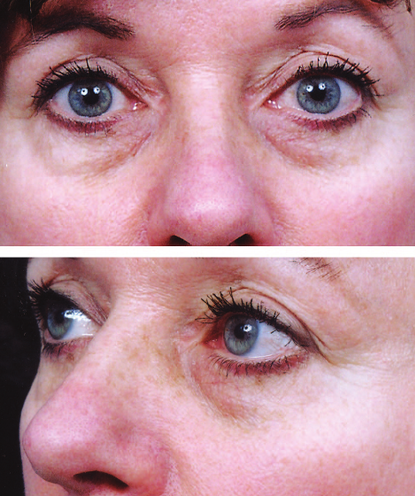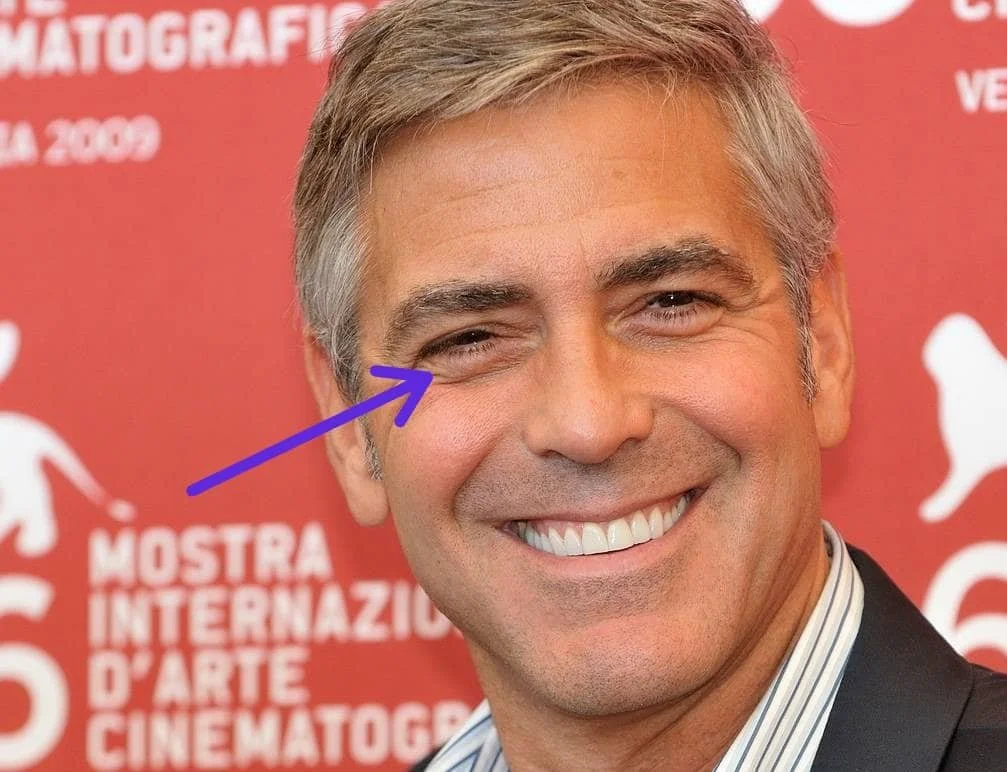What causes dark circles under your eyes?
The short answer
Dark circles under the eyes can result from true hyperpigmentation—caused by excess melanin, iron deposits, skin thickening, or visible blood vessels—or from shadowing effects due to changes in under-eye volume like hollowness or puffiness.
The long answer
Perhaps you've pulled an all-nighter and dark circles appeared under your eyes, or you've noticed that dark under-eye circles are common in your family, or you're a raccoon (sorry, raccoon buddy, this article isn't for you, but you look great).
Not the dark under-eye circles we'll be learning about today.
"Raccoon Cute Pose (cropped)" by Harlequeen is licensed under CC BY 2.0.
Dark circles under the eyes are very common and can result from a variety of factors, possibly several in combination. The causes of dark circles fall into two buckets: true hyperpigmentation (the skin is actually darker) and shadowing (the skin only appears darker).
Reason #1: True hyperpigmentation
With true hyperpigmentation, the actual skin below your eyes is a darker color than normal.
Cause #1: Excess melanin
Melanin is a pigment that colors skin, hair, and eyes and helps protect against UV exposure. We all have melanin, but people with darker skin tones have more of it than those with lighter skin tones.
Excessive amounts of melanin can get produced below the eyes for a variety of reasons. Some people have a genetic predisposition to more melanin below the eyes. And when the skin is exposed to lots of UV, melanin production can increase in order to protect you.
There's also a skin condition called post-inflammatory hyperpigmentation, which results in excessive melanin where there's been inflammation.
This woman has eczema. The chronic scratching of the eyes resulted in post-inflammatory hyperpigmentation.
Source: University of Cape Town
When the skin gets inflamed, inflammatory cells trigger the release of melanocytes (pigment cells) to produce more melanin, resulting in skin darkening. Chronic scratching of the eyes, trying new eye cream products, and more can cause post-inflammatory hyperpigmentation around the eyes.
Cause #2: Iron deposits
Iron, another naturally occurring pigment, can cause dark circles near the eyes. When blood vessels break, red blood cells release hemoglobin and its iron content can accumulate in the skin. This can produce a rusty, yellow-brown pigmentation of the skin, known as hemosiderin staining.
Source: Celibre Medical Association (modified)
A number of things can cause hemosiderin staining around the eyes: bruising, injuries after cosmetic, eye, or nose surgeries, iron overload disorders, and chronic inflammation resulting in more broken blood vessels from scratching.
Cause #3: Skin thickening
Rubbing your eyes a lot may also lead to thickening of the skin as your body adapts to the friction, a condition known as lichen simplex chronicus. Thickened skin appears darker than the surrounding thinner skin.
Source: Plastic Surgery Key (modified)
Cause #4: Thinner skin revealing blood vessels
But generally speaking, the skin around your eyes is very thin. If you have lighter or thinner skin, it will be easier to see the underlying parts, like blood vessels and eye muscles.
Poor blood circulation can make it easier to see the blood vessels under the skin around your eye. When blood has difficulty circulating, it can result in vasodilation, or widening of the blood vessels, in order to deliver more blood. Wider blood vessels are more prominent, and so they result in a darker hue under the eye.
"Vasodilation" by www.scientificanimations.com is licensed under CC BY-SA 4.0.
A bunch of things can contribute to more prominent vasodilation, most notably lack of sleep and prolonged screen time. When you skip your eight hours of beauty sleep, the oxygen in your eyes decreases. This causes your deoxygenated blood vessels to dilate, which makes them easier to see after your all-nighter.
A person who has been deprived of sleep.
Source: Veritas Shield
Staring at a screen for too long can also contribute to dark circles under your eyes because it puts your eyes under strain, which can cause the surrounding blood vessels to dilate.
However, blood vessels don't need to dilate to become more visible under your eyes. Certain things can make your skin appear thinner, which then makes vessels more visible. Dehydration, whether from not drinking enough water or drinking too much alcohol, can weaken and thin your skin, which contributes to the dark circles under your eyes.
Reason #2: Shadowing effects
Your skin doesn't have to actually be a different color to create the dark under-eye circles effect. If the area below your eyes becomes is hollower or fuller than "normal," shadowing can make dark circles appear.
Cause #1: Hollowness
The tissue below your eyes can either become hollower with age or simply be naturally more hollow because of genetics, creating an effect known as "tear troughs."
Some people genetically have a bone structure with more inset cheek bones or eye sockets or have less prominent fat pads underneath their eyes, leading to a shadowing dark circles effect. And as we age, fat pads can shrink and descend deeper into the face, and the orbital or cheek bones can become sunken as the body goes through bone resorption.
Cause #2: Fullness
Conversely, more fullness under the eyes can create a shadowing effect of dark circles. There are lots of reasons why someone's eyes might be fuller underneath.
Some people naturally have hypertrophy of the orbicularis oculi muscle, also cutely referred to as a "jelly roll." In my research, I learned that George Clooney is a prominent example of having a pronounced jelly roll, so here's an image of Clooney as promised.
Arrow pointing at George Clooney's Oscar-winning "jelly rolls."
"George Clooney 66ème Festival de Venise (Mostra) 2" (modified) by nicolas genin is licensed under CC BY-SA 2.0.
Age can also lead to a fuller effect under the eyes. As facial body tissues loosen, this can cause the fat pads under the eyes to push or bulge forward, in a medical condition known as pseudoherniation of suborbicularis oculi fibroadipose tissue (say that five times fast).
Diagram showing pseudoherniation of suborbicularis oculi fibroadipose tissue (fat pads bulging forward).
Source: Journal of Cutaneous and Aesthetic Surgery
But you don't need to age or be George Clooney to have a fuller under-eye look resulting in dark circles. Your eyes can become puffy with increased fluid retention (from things like salt consumption, allergies, or food sensitivities) and swelling (from rubbing or scratching the eyes).
As you can see, there are a ton of reasons why dark circles under the eye can appear. It's entirely possible that multiple factors can contribute to your dark circles. Here's your friendly reminder that I am most certainly not a doctor, so seek medical advice if you're concerned with your eyes.
Curious about how the world works?
Today You Should Know is a free, weekly email newsletter designed to help you learn something new every Friday.
Subscribe today 👇
Check out some other curious questions:
Sources
Celibre Medical Corporation. (2025, July 19). Understanding Hemosiderin Staining: Causes, Symptoms, and Treatment. Celibre Medical. https://celibre.com/hemosiderin-staining/
Cleveland Clinic. (2025, May 25). Dark Circles Under Eyes. Cleveland Clinic. https://my.clevelandclinic.org/health/symptoms/23128-dark-circles-under-eyes
Ellis, S. (2022, September 7). Can You Get Rid of Dark Circles Under Your Eyes? Dermatologist Explains | Dr. Sam Ellis. YouTube. https://www.youtube.com/watch?v=iAbxIK18B-E
Naidu, S. (2024, March 21). Why Does Lack Of Sleep Cause Bags under Eyes?. Shens Clinic. https://shensclinic.com/why-does-lack-of-sleep-cause-bags-under-eyes/
Rodrigues, M. (2014, September 28). Post-inflammatory hyperpigmentation. Australasian College of Dermatologists. https://www.dermcoll.edu.au/atoz/post-inflammatory-hyperpigmentation/
Southside Dermatology and Skin Cancer Surgery. (n.d.). The Impact of Sun Exposure on Hyperpigmentation. Southside Dermatology and Skin Cancer Surgery. https://www.dermatologyok.com/blog/1112088-the-impact-of-sun-exposure-on-hyperpigmentation
Turegano, M. (2024, March 21). A Dermatologist reveals why you get dark circles under your eyes | SELF IMPROVED. YouTube. https://www.youtube.com/watch?v=kIwMraENw5Y













It’s like an American accent but with calendars.